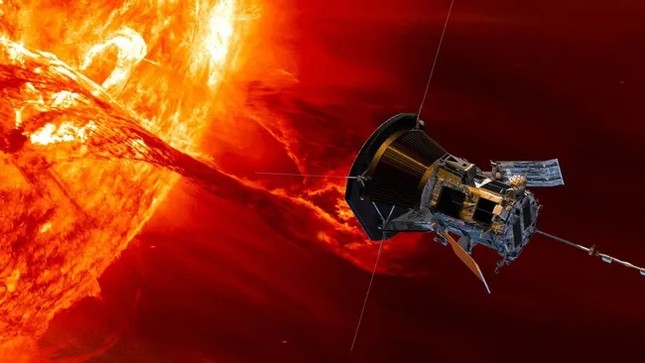TPO - NASA's Parker Solar Probe has found new clues to the long-standing mystery of why the sun's outer atmosphere, known as the corona, is so much hotter than our star's surface.
 |
The Parker Solar Probe made its 20th pass by the sun last month, searching for clues to the decades-old mystery of why the sun’s corona is hundreds of times hotter than its surface. (Image: NASA’s Applied Physics Laboratory and Goddard Space Flight Center) |
For decades, scientists have wondered why the sun's outer atmosphere, known as the corona, heats up as it moves away from the solar surface.
Now, thanks to data collected by NASA's Parker Solar Probe, which has repeatedly passed by the sun in search of clues to solving the so-called "coronal heating mystery."
During the probe's first pass by the sun, its instruments detected sudden reversals in the direction of the sun's magnetic field. Scientists call such events "reversals" and suspect they play a role in heating the corona, largely by releasing stored magnetic energy as they move through the sun and into space.
The corona is hundreds of times hotter than its "surface"
The mystery of the corona's heating has to do with the fact that the sun's outer atmosphere, the corona, is hundreds of times hotter than its "surface," the photosphere. This is despite the photosphere being millions of miles closer to the sun's core, where the nuclear fusion reactions that power our star take place.
Although cooler than the corona, the photosphere is responsible for the majority of the light from the Sun, completely "washing out" the light from the solar atmosphere. Therefore, the solar corona can only be seen when the light from the photosphere is blocked by an eclipse or by using a special instrument called a coronagraph.
That means that to study the corona, the Parker Solar Probe must endure temperatures of around 1,400 degrees Celsius to get closer to the sun.
The probe's data show that the deflection is a common phenomenon in the solar wind near the sun. This finding suggests that the zigzag motion that heats the corona may not originate on the surface of the sun, ruling out one of two main theories about the origin of the zigzag motion.
Scientists think there may still be a triggering mechanism that contributes to the heating of the outermost part of the sun. Such a mechanism could be the explosive collision of chaotic magnetic field lines on the solar surface, Akhavan-Tafti said.
This research helps us better understand how the sun works and could eventually help scientists predict, detect and prepare for solar storms.
This is the latest result from NASA's Parker mission since it began in 2018. Scientists hope data from Parker's trips will reveal more about why the corona is so hot at millions of degrees.
According to Live Science
Source: https://tienphong.vn/tim-thay-manh-moi-moi-ve-bi-an-keo-dai-hang-thap-ky-xung-quanh-mat-troi-post1663473.tpo





































































































Comment (0)